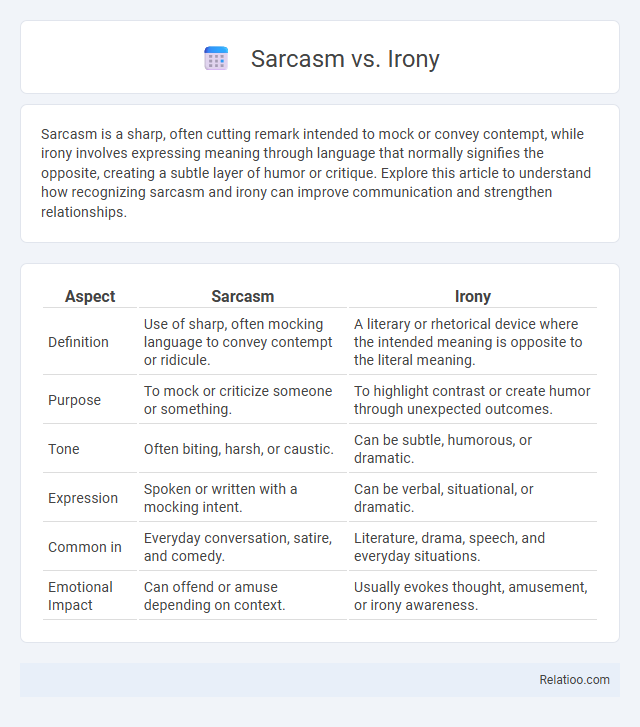Sarcasm is a sharp, often cutting remark intended to mock or convey contempt, while irony involves expressing meaning through language that normally signifies the opposite, creating a subtle layer of humor or critique. Explore this article to understand how recognizing sarcasm and irony can improve communication and strengthen relationships.
Table of Comparison
| Aspect | Sarcasm | Irony |
|---|---|---|
| Definition | Use of sharp, often mocking language to convey contempt or ridicule. | A literary or rhetorical device where the intended meaning is opposite to the literal meaning. |
| Purpose | To mock or criticize someone or something. | To highlight contrast or create humor through unexpected outcomes. |
| Tone | Often biting, harsh, or caustic. | Can be subtle, humorous, or dramatic. |
| Expression | Spoken or written with a mocking intent. | Can be verbal, situational, or dramatic. |
| Common in | Everyday conversation, satire, and comedy. | Literature, drama, speech, and everyday situations. |
| Emotional Impact | Can offend or amuse depending on context. | Usually evokes thought, amusement, or irony awareness. |
Understanding Sarcasm and Irony
Understanding sarcasm involves recognizing a sharp, often mocking tone where the intended meaning contrasts with the literal words, primarily used to convey contempt or humor. Irony encompasses a broader concept where an outcome or expression is incongruent with expectations, including verbal, situational, and dramatic forms that highlight contrast between appearance and reality. Differentiating sarcasm from irony requires noting sarcasm's direct, aggressive intent versus irony's subtle, situational contrast.
Key Differences Between Sarcasm and Irony
Sarcasm is a form of verbal irony where the speaker says the opposite of what they mean to mock or convey contempt, often with a biting tone. Irony encompasses a broader range of situations including verbal, situational, and dramatic, where there is a contrast between expectation and reality. Understanding these key differences helps you recognize when language is used to humorously criticize (sarcasm) versus when it highlights a deeper incongruity without direct insult (irony).
Origins and Evolution of Sarcasm
Sarcasm, originating from the Greek word "sarkazein," meaning "to tear flesh," evolved as a sharp, biting form of verbal irony intended to mock or convey contempt. Unlike irony, which broadly refers to a discrepancy between expectations and reality, sarcasm specifically uses tone and context to highlight this contrast with cutting humor. Your understanding of sarcasm deepens when recognizing its historical roots and how its evolution has shaped modern communication, often blurring lines with irony.
The Historical Roots of Irony
Irony traces its roots to ancient Greek literature, where playwrights like Sophocles and Aristophanes used it to convey meanings opposite to the literal sense, often to critique society or provoke thought. Sarcasm, a sharper, more biting form of irony, evolved later as a verbal tool for mockery and ridicule, distinct in tone and intent from the broader concept of irony. Both rely on a contrast between appearance and reality, but irony's historical foundation emphasizes subtlety and layered meaning over sarcasm's directness.
How Sarcasm Works in Communication
Sarcasm functions as a form of verbal irony where the speaker says something opposite to their true meaning to convey humor, criticism, or emphasis. It relies heavily on tone of voice, facial expressions, and context to signal the intended meaning, creating a layer of implied meaning understood by the listener. Effective sarcasm in communication depends on shared knowledge and social cues, enabling subtle conveyance of attitudes or emotions without direct statements.
Irony in Everyday Conversations
Irony in everyday conversations often involves saying the opposite of what one means to highlight a discrepancy between reality and expectation, creating subtle humor or emphasis. Unlike sarcasm, which is typically sharper and intended to mock or convey contempt, irony can be more nuanced and indirect, making it a versatile tool in communication. Understanding the distinctions between sarcasm and irony helps you interpret tone and intention accurately in daily interactions.
Psychological Effects of Sarcasm and Irony
Sarcasm and irony often overlap but differ in intent and delivery, with sarcasm typically aiming to mock or convey contempt, while irony highlights contradictions between expectations and reality. The psychological effects of sarcasm can include increased stress and social tension due to its aggressive tone, whereas irony, when used gently, may promote critical thinking and emotional relief by highlighting absurdities. Your understanding of these nuances can help navigate social interactions, balancing humor with sensitivity to avoid misunderstandings or negative emotional impacts.
Cultural Variations in Sarcasm and Irony
Sarcasm and irony often vary significantly across cultures, impacting their interpretation and social functions; for example, British humor frequently employs irony as subtle social critique, while American sarcasm tends to be more direct and biting. Cultural norms influence how sarcasm is perceived, with some societies viewing it as playful wit and others as potentially offensive or disrespectful. Understanding these variations is crucial for cross-cultural communication to avoid misinterpretations and foster effective interpersonal interactions.
Recognizing Sarcasm vs Irony in Literature
Recognizing sarcasm versus irony in literature involves understanding their distinct purposes and expressions; irony typically conveys a contrast between expectation and reality, often producing subtle humor or criticism, while sarcasm uses sharp, cutting remarks intended to mock or convey contempt. Sarcasm is a form of verbal irony but is more direct and hostile, often relying on tone and context clues for accurate interpretation. Identifying sarcasm and irony requires attention to the author's linguistic cues, situational context, and character intent within the narrative framework.
Tips for Using Sarcasm and Irony Effectively
Using sarcasm effectively requires clear vocal tone and context to avoid misunderstandings, making sure the listener recognizes the contrast between literal and intended meaning. Irony thrives on subtlety and often depends on situational or dramatic contexts to highlight discrepancies between expectation and reality without overt mockery. Balancing timing and audience awareness enhances both sarcasm and irony, ensuring humor or critique is impactful without causing offense.

Infographic: Sarcasm vs Irony
 relatioo.com
relatioo.com